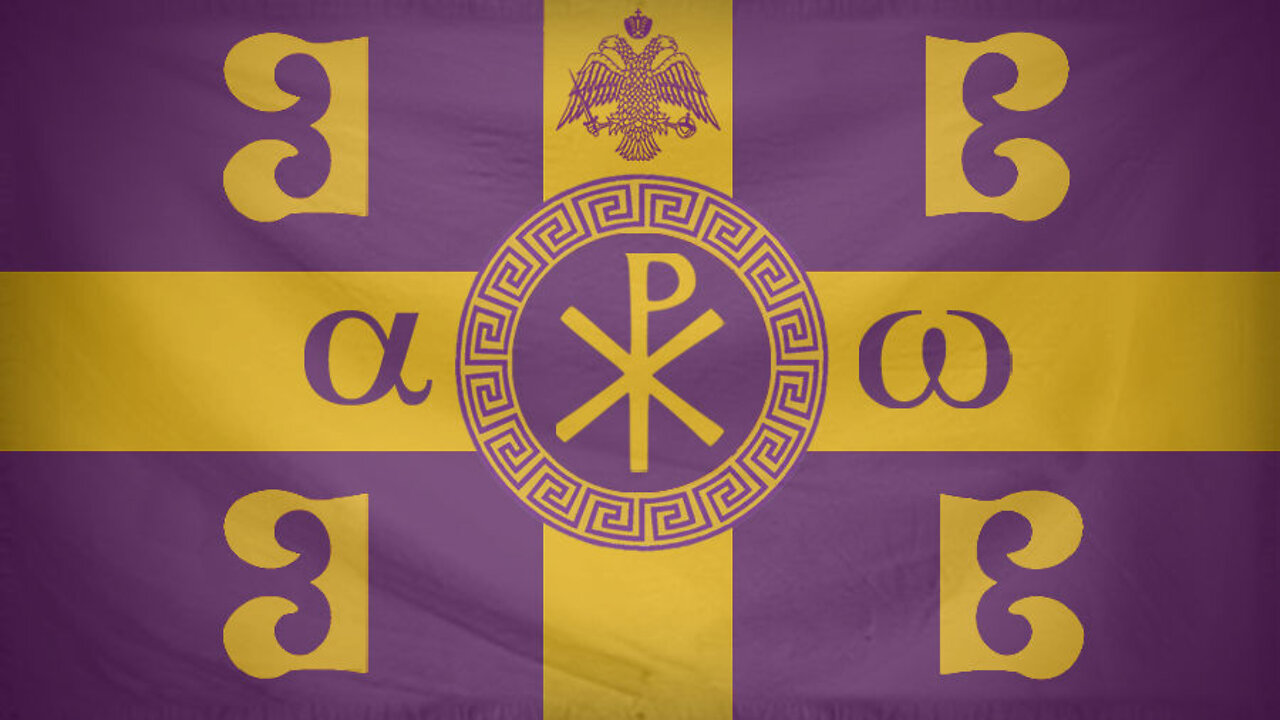Premium Only Content

#IMPERIVM ROMANVM : α☧ω 🦅🦅 #ββββ : βασιλεὺς βασιλέων, βασιλεύων βασιλευόντων
#IMPERIVM ROMANVM : α☧ω 🦅🦅 #ββββ : βασιλεὺς βασιλέων, βασιλεύων βασιλευόντων
http://zazzle.com/ProVaticanus
This Roman Imperial standard-flag is based on the tetragrammic cross emblem/flag of the Byzantine Palaiologos dynasty, with the difference that in Serbian use the cross is usually white on a red background, rather than gold on a red background (though it can be depicted in gold as well). It is composed of a cross symbol with four "fire striker" shapes, originally four Greek letters beta (Β). The so called ‘ocila' in Serbian or ‘fire strikers' in English are the initials (letters β) of the imperial motto of the Palaiologos dynasty: King of Kings, Ruling Over Kings. In Greek it goes like this: βασιλεὺς βασιλέων, βασιλεύων βασιλευόντων; (Basileus Basileōn, Basileuōn Basileuontōn)
The emblem mostly associated with the Roman Empire in the East (Byzantine) is the double-headed eagle. It is not of Byzantine invention, but a traditional Anatolian motif dating to Hittite times, and the Byzantines themselves only used it in the last centuries of the Empire. The date of its adoption by the Byzantines has been hotly debated by scholars. In 1861, the Greek scholar Georgios Chrysovergis wrote that it was adopted by the Komnenoi in 1048.
The Palaiologan emperors used the double-headed eagle as a symbol of the senior members of the imperial family. It was mostly used on clothes and other accoutrements, as codified in the mid-14th century by pseudo-Kodinos in his Book of Offices. According to Kodinos, the emperor bore special boots (tzangia) with eagles made of pearls on both shins and on the instep; the Despots wore similar boots of white and purple, and featured pearl-embroidered eagles on their saddles, while the saddle cloth and their tents were white decorated with red eagles. Similarly, the sebastokrator wore blue boots with golden wire-embroidered eagles on a red background, while his saddle cloth was blue with four red embroidered eagles. The only occasion the double-headed eagle appears on a flag is on the ship that bore Emperor John VIII Palaiologos to the Council of Florence, as mentioned by Sphrantzes and confirmed by its depiction in the Filarete Doors of St. Peter's Basilica. According to a handful of surviving examples, such as the supposed "Flag of Andronikos II Palaiologos" in the Vatopedi Monastery, or a frontispiece of a Bible belonging to Demetrios Palaiologos, the Byzantine double-headed eagle was golden on a red background. Likewise, in Western armorials from the 15th century, the golden double-headed eagle on a red shield is given as the arms of the "Empire of the East" or "of Constantinople", or as emblem of members of the imperial family. The representation of the eagle on a shield is an adaptation to Western heraldic practice, however; the Byzantines never used it in this manner for themselves, although they employed it in a Western context, e.g. in the award of the right to bear the imperial arms to the Florentine citizen Giacomo Paolo di Morellis in 1439.
Within the Byzantine world, the eagle was also used by the semi-autonomous Despots of the Morea, who were younger imperial princes, and by the Gattilusi of Lesbos, who were Palaiologan relatives and vassals. The double-headed eagle was used in the breakaway Empire of Trebizond as well, being attested imperial clothes but also on flags. Indeed, Western portolans of the 14th–15th centuries use the double-headed eagle (silver/golden on red/vermilion) as the symbol of Trebizond rather than Constantinople. Single-headed eagles are also attested in Trapezuntine coins, and a 1421 source depicts the Trapezuntine flag as yellow with a red single-headed eagle. Apparently, just as in the metropolitan Byzantine state, the use of both motifs, single and double-headed, continued side by side. Double-headed eagle reliefs are also attested for the walls of Trebizond, with one example preserved in a church in Kalamaria, Thessaloniki, which is very similar to 13th-century Seljuq examples. Modern scholars commonly consider the double-headed eagle to have been adopted by the Grand Komnenos emperors of Trebizond after their recognition of the suzerainty of, and intermarriage with, the Palaiologos dynasty in the 1280s. Likewise, the small Byzantine Principality of Theodoro in the Crimea, whose rulers conducted marriage alliances with both the Palaiologoi and the Grand Komnenoi, also used the double-headed eagle in the 15th century.
#XP #SPQR #Imperium #RomanEmpire #Byzantine #Orthodoxy #Labarum #Rome #Constantinople #EasternRomanEmpire #ByzantineEmpire #Romanoi #Orthodox #Catholic #Palaiologos #CouncilOfFlorence #ByzantineMusic #Anthem #RomanFlag #Vexillum #Ekklesia #Reunion #ChurchState #ConstantineTheGreat #TheodosiusTheGreat #JohnVIII #ConstantineXI #Patria #DoubleEagle #4Beta #AlphaOmega #ChiRho #Serbia #Greece #Italia #TheEmpire #TheRepublic
Ago tibi gratias Deo per instrumenta de "Zzen" pro bono rei publicae.
-
 1:48
1:48
ProVaticanus
1 month ago«Victimæ Paschali Laudes» ex Missa Paschali in Cathedrali S. Christophori Rœrmondi (5 Apr. 1953)
101 -
 1:01
1:01
BeeHappy
4 years agoEAGLESY 🦅🦅
20 -
 LIVE
LIVE
JULIE GREEN MINISTRIES
1 hour agoLIVE WITH JULIE
20,984 watching -
 19:15
19:15
Melonie Mac
19 hours agoCrystal Dynamics laid off a bunch of people - what does this mean for Tomb Raider?
23.9K36 -
 12:48
12:48
Degenerate Jay
1 day ago $0.45 earnedThe Fox X-Men Are Back! Avengers Doomsday Secrets Revealed!
3.7K6 -
 28:29
28:29
CatfishedOnline
1 day agoFamily Has To Stop Dad From Marrying A Romance Scammer!
9.3K5 -
 13:51
13:51
Adam Does Movies
21 hours ago $1.01 earnedPeople On Their Phones At The Movies Are SCUM! - RANT!
4.3K10 -
 46:07
46:07
The Rich Dad Channel
18 hours agoThis Coach Will Change How You Think About Success - Andy Tanner, Matthew Mitchell
8.54K2 -
 6:06
6:06
Dr. Nick Zyrowski
22 hours agoHigh Dose Glutathione Treats Incurable Disease - (Real Anti-Aging)
5.66K2 -
 14:09
14:09
IsaacButterfield
1 day ago $0.89 earnedRaygun’s Family in Court | Woke School Bans Sports | The American Wombat Thief Update!
11K4